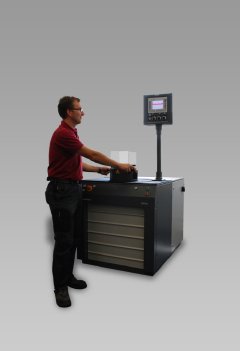The new BUP200 sheet metal testing machine was developed in response to new materials with higher strength properties and associated ductility behavior, together with increasing demands on component quality. The machine now provides punching and clamping forces up to 250 kN and, with its new and fresh design, the BUP200 completes the successful portfolio of sheet metal testing machines up to 1000 kN.
 The new sheet metal testing machine with a maximum test load of 200 kN covers all popular standards in sheet metal forming and can be used equally well for determining essential material properties or quality assurance in sheet metalworking.
The new sheet metal testing machine with a maximum test load of 200 kN covers all popular standards in sheet metal forming and can be used equally well for determining essential material properties or quality assurance in sheet metalworking.
Zwick's latest machine has a maximum drawing force of 200 kN and covers all commonly used standards for sheet metal testing (e.g. EN ISO 20482, and EN 1669). It can be used for determining material properties as required or for quality control in sheet-metal processing.
The control system is based on programmable logic control, with test parameters entered numerically via a display with direct input function. Clamping force and deep drawing speed are regulated through proportional control valves as specified by the operator. Measured values can be read off conveniently from the attractive color display. On request Zwick can also program customized test sequences such as clamping force or deep drawing speed as a function of ram stroke.
Typical uses for the BUP 200 include the determination of properties for deep drawing or stretch-forming to standard procedures, plus other important applications such as determination of forming limit curves and hole expansion tests. A further example of the machine's wide range of application options is process monitoring during surface treatments, for example lubricant coating and application.
For detailed investigations of the forming process the ram force, clamping force and ram stroke can be read out via the testControl electronics and stored, processed and analysed via Zwick's proprietary testXpert II software.
Zwick's new testXpert Master Test Program Evaluation Software for BUP gives sheet-metal manufacturers and processors access to a software package which offers significant advantages in use, such as freely definable curve representation of analog or digital input signals, online display of actual measured values, start and stop of test and data logging via external signals, together with calculation of deep drawing speed and results displayed in freely configurable reports. The measured values are used for test control at machine level, for approaching defined force and travel values, for detecting incipient specimen failure and for controlled termination of the test.
The advantages of the new sheet metals testing machine lie in its flexibility, with fast, easy fixture changes for various tests and individually controllable functions such as holding down, punching, drawing and ejection.
Transport and maintenance are greatly simplified by the introduction of a closed and encapsulated oil circuit. Particular attention was paid to achieving low piston-cylinder friction, ensuring high reproducibility and accurate data acquisition.
Safety in operation is also a primary consideration; all functions have hydraulic and electrical fuses and conform to the latest safety standards. Two-handed operation is incorporated as standard for increased operator safety when closing the blank holder. This compact testing machine is easy to transport, clean and quiet in operation and robust enough to guarantee many years of continuous operation.